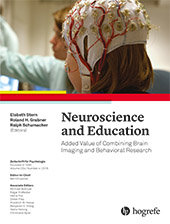Development of Reading Remediation for Dyslexic Individuals
Added Benefits of the Joint Consideration of Neurophysiological and Behavioral Data
Abstract
Abstract. Dyslexia is a phenomenon for which the brain correlates have been studied since the beginning of the 20th century. Simultaneously, the field of education has also been studying dyslexia and its remediation, mainly through behavioral data. The last two decades have seen a growing interest in integrating neuroscience and education. This article provides a quick overview of pertinent scientific literature involving neurophysiological data on functional brain differences in dyslexia and discusses their very limited influence on the development of reading remediation for dyslexic individuals. Nevertheless, it appears that if certain conditions are met – related to the key elements of educational neuroscience and to the nature of the research questions – conceivable benefits can be expected from the integration of neurophysiological data with educational research. When neurophysiological data can be employed to overcome the limits of using behavioral data alone, researchers can both unravel phenomenon otherwise impossible to document and raise new questions.
References
. (2013). Diagnostic and statistical manual of mental disorders (5th ed.). Washington, DC: Author.
(2002). Spanning seven orders of magnitude: A challenge for cognitive modeling. Cognitive Science, 26, 85–112. doi: 10.1016/S0364-0213(01)00062-3
(2011). Connecting education and cognitive neuroscience: Where will the journey take us? Educational Philosophy and Theory, 43, 37–42. doi: 10.1111/j.1469-5812.2010.00705.x
(2014). Neuroimaging of reading intervention: A systematic review and activation likelihood estimate meta-analysis. PLoS One, 9, e83668. doi: 10.1371/journal.pone.0083668
(2001).
James Hinshelwood (1859–1919) and developmental dyslexia . In F. Clifford-RoseEd., Twentieth century neurology: The British contribution (pp. 59–76). London, UK: Imperial College Press.(1999). Phonological awareness and early reading: A meta-analysis of experimental training studies. Journal of Educational Psychology, 91, 403–414. doi: 10.1037/0022-0663.91.3.403
(2012).
How neuroscience contributes to our understanding of learning and development in typically developing and special-needs students . In K. R. HarrisS. GrahamT. UrdanC. B. McCormickG. M. SinatraJ. SwellerEds., APA educational psychology handbook, Vol 1: Theories, constructs, and critical issues (pp. 561–595). Washington, DC: American Psychological Association.(2012).
Neuroscience, education and educational efficacy research . In S. Della SalaM. AndersonEds., Neuroscience in education: The good, the bad, and the ugly (pp. 7–14). New York, NY: Oxford University Press.(2014). Advances in the use of neuroscience methods in research on learning and instruction. Frontline Learning Research, 6. doi: 10.14786/flr.v2i4.115
(2006). An evaluation of intensive intervention for students with persistent reading difficulties. Journal of Learning Disabilities, 39, 447–466. doi: 10.1177/00222194060390050601
(2001). Systematic phonics instruction helps students learn to read: Evidence from the National Reading Panel’s meta-analysis. Review of Educational Research, 71, 393–447. doi: 10.3102/00346543071003393
(2001). Phonemic awareness instruction helps children learn to read: Evidence from the National Reading Panel’s meta-analysis. Reading Research Quarterly, 36, 250–287. doi: 10.1598/RRQ.36.3.2
(2009). Dyslexia: A new synergy between education and cognitive neuroscience. Science, 325, 280–283. doi: 10.1126/science.1171999
(2007). Functional and morphometric brain dissociation between dyslexia and reading ability. Proceedings of the National Academy of Sciences of the United States of America, 104, 4234–4239. doi: 10.1073/pnas.0609399104
(2012). Three requirements for justifying an educational neuroscience. The British Journal of Educational Psychology, 82, 1–23. doi: 10.1111/j.2044-8279.2012.02068.x
(2011). Neuroscience and Reading: A Review for Reading Education Researchers. Reading Research Quarterly, 46, 156–172. doi: 10.1598/RRQ.46.2.4
. (2007). Dyslexie, Dysorthographie, Dyscalculie: Bilan des données scientifiques
[Dyslexia, dysorthography, dyscalculia: Conclusions from scientific data] . Paris, France: Author.. (2002). Definition of Dyslexia.Retrieved from http://eida.org/definition-of-dyslexia/
(2001). Routes to reading success and failure. Hove, UK: Psychology Press.
(2004). Theories of conduct disorder: A causal modelling analysis. Journal of Child Psychology and Psychiatry, 45, 727–742. doi: 10.1111/j.1469-7610.2004.00267.x
(2003). Defining dyslexia, comorbidity, teacher’s knowledge of language and reading: A definition of dyslexia. Annals of Dyslexia, 53, 1–14. doi: 10.1007/s11881-003-0001-9
(2005). An evaluation of two reading interventions derived from diverse models. Reading Research Quarterly, 40, 148–182. doi: 10.1598/RRQ.40.2.2
(1995).
Causal modelling: A structural approach to developmental psychopathology . In D. CicchettiD. J. CohenEds., Developmental psychopathology. Volume 1. Theory and methods (pp. 357–390). New York, NY: Wiley.(2001).
Why we need cognition: Cause and developmental disorder . In E. DupouxEd., Language, Brain, and Cognitive Development (pp. 263–278). Cambridge, MA: The MIT Press.. (2008). Developing early literacy: A scientific synthesis of early literacy development and implications for intervention. Denver, CO: National Institute for Literacy & Partnership for Reading.
. (2014). What are reading disorders? Retrieved from https://www.nichd.nih.gov/health/topics/reading/conditioninfo/pages/disorders.aspx
. (2000). Teaching children to read: An evidence-based assessment of the scientific research literature on reading and its implications for reading instruction. Bethesda, MD: National Institute of Child Health and Development. Retrieved from http://www.nichd.nih.gov/publications/nrp/report.htm
(2015). Neurobiology of dyslexia. Current Opinion in Neurobiology, 30, 73–78. doi: 10.1016/j.conb.2014.09.007
(2014). Brain mechanisms and reading remediation: More questions than answers. Scientifica, 2014, 802741. doi: 10.1155/2014/802741
(2012). Developmental dyslexia. The Lancet, 379, 1997–2007. doi: 10.1016/S0140-6736%2812%2960198-6
(2000). Functional neuroimaging studies of reading and reading disability (developmental dyslexia). Mental Retardation and Developmental Disabilities Research Reviews, 6, 207–213. doi: 10.1002/1098-2779(2000)6:3<207::AID-MRDD8>3.0.CO;2-P
(2012). Functional characteristics of developmental dyslexia in left-hemispheric posterior brain regions predate reading onset. Proceedings of the National Academy of Sciences of the United States of America, 109, 2156–2161. doi: 10.1073/pnas.1107721109
(2009). Functional abnormalities in the dyslexic brain: A quantitative meta-analysis of neuroimaging studies. Human Brain Mapping, 30, 3299–3308. doi: 10.1002/hbm.20752
(2011). Meta-analyzing brain dysfunctions in dyslexic children and adults. NeuroImage, 56, 1735–1742. doi: 10.1016/j.neuroimage.2011.02.040
(2003). Overcoming dyslexia: A new complete science-based program for reading problems at any level. New York, NY: Knopf.
(2006). The role of functional magnetic resonance imaging in understanding reading and dyslexia. Developmental Neuropsychology, 30, 613–632. doi: 10.1207/s15326942dn3001_5
(2007). Altering the brain circuits for reading through intervention: A magnetic source imaging study. Neuropsychology, 21, 485–496. doi: 10.1037/0894-4105.21.4.485
(2000). Dyslexia (2nd ed.). Oxford, UK: Wiley-Blackwell.
(2015). Building bridges between neuroscience, cognition and education with predictive modeling. Mind, Brain and Education, 9, 121–126. doi: 10.1111/mbe.12076
(1999). Interventions for students with learning disabilities. New York, NY: Guilford.
(2009). Lexical processing skill in college-age resilient readers. Reading and Writing, 22, 353–371. doi: 10.1007/s11145-008-9120-3



